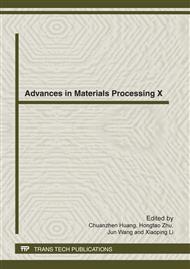p.82
p.89
p.94
p.99
p.105
p.111
p.117
p.123
p.128
A Study of Cutting Forces in High-Speed Dry Milling of Inconel 718
Abstract:
nconel 718 is one of the most commercially important superalloys but with very poor machinability. It has a very high yield stress and a high tendency to adhesion and work-hardening. A recent trend of improving the machining processes of difficult-to-cut materials is to move towards dry cutting operations. This paper presents an experimental study of the cutting forces in high speed dry milling of Inconel 718 using a milling cutter with coated carbide inserts. It is found that the peak cutting forces increase with an increase in chip load in a nonlinear way, but cutting speed does not show a significant influence on the cutting force for the range of cutting speeds tested in this study.
Info:
Periodical:
Pages:
105-110
Citation:
Online since:
April 2012
Authors:
Keywords:
Price:
Сopyright:
© 2012 Trans Tech Publications Ltd. All Rights Reserved
Share:
Citation:


